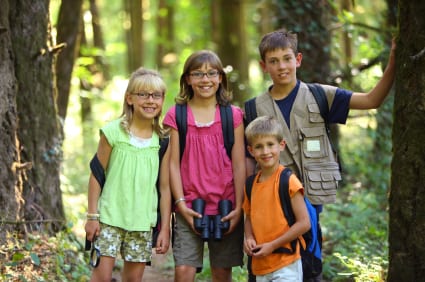A family hiking trip allows kids to explore nature while getting exercise, but the activity also presents dangers. Preparing for the trip before you leave helps identify and avoid the potential dangers and makes for a more enjoyable hiking trip. Whether you take a short hike for an hour or hike the entire day or longer, the proper supplies and precautions help everyone get home safely.
Preparation
Planning your hike before you leave home increases the chances of staying safe once you hit the trail. A map of the area trails allows you to plot your hiking route so you can plan the details. The age of your children and the terrain dictates how far you can travel while hiking. Add extra time for stopping to explore the nature you encounter along the way. A general schedule for breaks and meals helps guide the day.
Supplies
The supplies necessary depend primarily on the length of the hike. If you are only going for a few hours, you won’t need as many supplies as you would for a full day hike. A first-aid kit is essential no matter how long you are on the trail. A whistle is another needed safety item, because it allows you to identify your location if you are lost. Give each family member a whistle in case you get separated. Enough food and water to last the duration of the hike, insect repellent, sunscreen and a map of the area rounds out the list.
Packing
A backpack typically works well for carrying the necessary supplies to keep your family safe. If your child will wear a backpack, keep the bag lightweight so it doesn’t become too heavy for her. An adult is usually a better option for carrying the supplies.
Clothing
Clothing selection protects kids from insect bites and injuries while hiking. Choose long-sleeved shirts and pants, if the weather allows. This keeps as much of the skin as possible covered during the hike to protect against scrapes and bites. The longer articles of clothing also protect the skin from sunburn. Dressing in layers allows you to adjust your child’s outfit in case he gets cold or hot. If you are hiking in colder weather, bring gloves hats and a coat to prevent frostbite. In hot weather, wear clothes that keep the body cool and hydrate often to avoid heat exhaustion.
Considerations
Potential dangers in the area should be identified before hitting the trail. For example, if there are poisonous snakes or plants along the trail, you should know what they look like so you can avoid them. Teach your children to avoid the dangerous species as well. Before you start hiking, find a park ranger where you are camping. He can tell you where the nearest medical help is in case you do end up with an injury.





